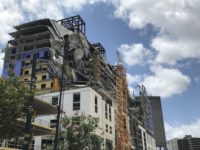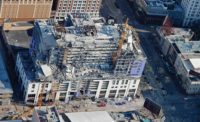With the remains of the Hard Rock Hotel site now clear of debris, the City of New Orleans is facing a multimillion-dollar series of infrastructure repairs to fix damages that resulted from the fatal collapse of the hotel and its subsequent demolition. Three people were killed when the upper floors of the 18-story building collapsed on Oct. 12, 2019, and two victims’ bodies remained trapped in the rubble for 10 months.
The city does not yet have a final tally of the damages since repairs are still under way. But New Orleans deputy chief administrative officer Ramsey Green told ENR that the city is looking at well over $5 million in repairs to underground city utilities, streetcar lines, sidewalks, roads and streetscapes on Canal and Rampart streets. That’s in addition to roof repairs in progress at the city-owned Saenger Theatre, located next door to the Hard Rock site.
“All of that needs to get back to normal, and it’s running a tab that costs a lot of money to get done,” Green says.
On Rampart Street, the Sewerage & Water Board of New Orleans in May completed repairs to a water line that was punctured by one of two tower cranes that came down in a controlled implosion. “When that crane was detonated, it shot straight into Rampart Street, sort of like a lawn dart. And it went about 20 ft into the ground and cut a water line,” Green says.
The city continues to repair damage that occurred when pieces of building debris fell in the collapse. Landscaping on Canal Street and the overhead lines powering streetcars on Canal and Rampart streets will also need replacement. Some were damaged by debris, while others had to be taken down so cranes could move into place for demolition.
New Orleans-based Landis Construction Co. is repairing the roof of the Saenger Theatre, which Green says received a substantial amount of damage from falling debris. A fallen tower crane punctured the roof during the Oct. 12 building collapse. The city expects to complete those repairs in July.
The New Orleans Regional Authority is on schedule to restore streetcar service on Canal Street to the Mississippi River by mid-July and the Rampart line by this fall. The RTA restarted service from Canal onto Loyola Drive in April. Meanwhile, two-way vehicle traffic reopened on Canal Street in late April, and city is on track to reopen one lane of traffic each way on North Rampart Street by mid-July, Green says.
Green predicts that by the end of 2021, operations and the visual appearance of the area surrounding the hotel should be back to normal.
“There’s still work to do,” Green says. “We need these streets open. We need streetcars operating.”
The repairs are under way amidst an ongoing lawsuit the city filed against the hotel’s developer, 1031 Canal, and more than a dozen contractors, engineers and insurers. The suit claims that the hotel collapse and response efforts put a strain on city resources and damaged local infrastructure, costing taxpayers over $12.3 million.
The start of the infrastructure repairs follows the completion of an $8.4 million demolition, in which crews used wrecking balls, shears and other tools to take down the remnants of the building. The demolition contractor finished clearing debris and left the site in early April, almost a full year after crews began dismantling the structure piece by piece in May 2020.
Initial projections were for the site to be clear by late 2020 or early 2021, but weather and equipment issues created multiple setbacks.
Major demolition work was also delayed until August, after crews were able to recover the bodies of two workers, Jose Ponce Arreola and Quinnyon Wimberly. The body of a third victim, Anthony Magrette, was recovered two days after the collapse.
Once major demolition work began, crews had to use a wrecking ball to break the slab before they could cut down the steel, and some parts of the building were harder to get down than expected, says structural engineer Walter Zehner, the local expert of St. Louis-based SID Engineering and part of the demolition team led by Kolb Grading and Marschel Wrecking, both of Missouri.
“It was a challenge to get it down to the point where they could start hauling everything off,” Zehner says.
Because the concrete structure was a post-tensioned slab, demolition had to take place in an opposite sequence from how it was built. “It was almost like turning a film backwards,” he says.
Once everything came down, it took crews nearly a month to haul off the nearly 9,000 cu yd of concrete from the site.
The future of the Hard Rock site is still in question, and New Orleans City Council members have taken steps to make sure another high-rise doesn’t go in that site. Earlier this year, Council members supported a motion to revoke the developer’s site permit, given that the Hard Rock would have been three times taller than city regulations would otherwise allow.




Post a comment to this article
Report Abusive Comment